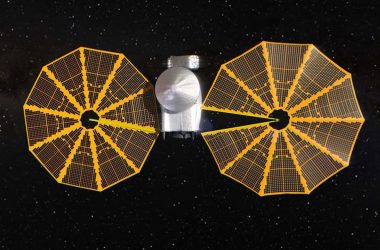The planetary system PDS features a star at its centre (in large white circle), orbited by the planet PDS 70b (in solid white circle) and a cloud of debris (in dotted white circle). Further out, the large yellow ring is a planet-forming circumstellar disc and there is another planet, PDS 70c, on its inner edge
ALMA (ESO/NAOJ/NRAO) /Balsalobre-Ruza et al.
Astronomers have made a fascinating discovery in a star system located around 400 light years away. In this system, a still-forming planet seems to be sharing the orbit of a gas giant that is already present. This potential finding, if confirmed, would be the first time we have observed two planets sharing an orbit. While we are aware of the existence of trojan asteroids that co-orbit with Jupiter and some around Earth, these are believed to have been captured by the gravitational fields of the planets, rather than having formed in place.
Álvaro Ribas and his colleagues from the University of Cambridge have observed a dust cloud in the same orbit as the exoplanet PDS 70b, a gas giant that is still in the early stages of formation. This dust cloud could either indicate the formation of a new planet or the remnants of a previously formed planet. Ribas suggests that if this is true and if this leads to the formation of asteroids, moons, and potentially terrestrial planets, it could imply that trojan-like objects can be born in situ.
To locate the second planet, Ribas and his team used the Atacama Large Millimeter/submillimeter Array (ALMA) in Chile, the second-largest telescope in the world. They examined PDS 70b’s Lagrangian points, which are gravitationally stable areas where trojan bodies are likely to exist. They discovered a ball of dust composed of centimeter-sized rocks, with a mass similar to Earth’s moon.
This star system is extremely young, and the presence of this orbital material suggests that it formed along with the planet. According to Matija Cuk from the SETI Institute, this characteristic is not observed in our own solar system.
At present, we only have limited information about this suspected planet, although its position aligns with what we would expect if it were co-orbiting. To confirm its orbit fully, further observations will be required in February 2026. Additionally, to learn more about its composition, we may have to wait until 2030 when ALMA undergoes an upgrade, according to Ribas.
Once more is known, the question arises of what to name this object. The International Astronomical Union (IAU) defines a planet as the only dominant mass in its gravitational district, a condition referred to as “clearing the neighborhood.” This is why Pluto was reclassified as a dwarf planet since its moon Charon has enough mass to exert gravitational influence on its own. Ribas mentions that if something forms at the Lagrangian point with a mass equivalent to Earth, it would challenge the IAU’s definition of a planet. However, it is worth noting that the IAU’s definition applies formally to planets within the solar system, making the status of this potential planet a gray area.
Topics:












